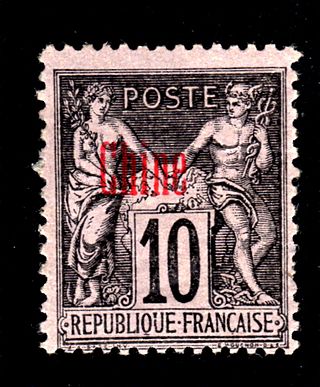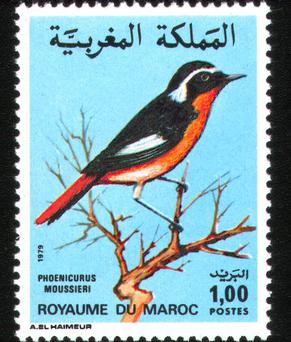First office
The first office was established in Tangier in 1857; mail was simply bagged there and forwarded to Gibraltar just across the water, where it received the standard "A26" postmark. From 1872 Tangier had its own postmark, but this was applied alongside the stamps (allowing for the Gibraltar cancellation to mark them), so usages of British stamps from Morocco are best determined on cover. Several examples of loose GB Queen Victoria stamps cancelled Tangier do exist including at least one horizontal strip of 6 1d reds from plate 123.This item was lot 417 in the H R Harmer sale on 12–14 December 1960.
Since the offices were under the control of Gibraltar, they switched to the use of Gibraltar stamps when they came into use, on 1 January 1886. Additional offices opened in various Moroccan seaports during the 1880s, and inland at Fez (1892), and Meknes (1907).
The stamps were overprinted "Morocco / Agencies" beginning in 1898, initially at the offices of the Gibraltar Chronicle , [1] and then later in London, yielding several variations in the appearance of the overprint.
Direct control
On 1 January 1907, the British Post Office took direct control of the post offices, operating them until Moroccan independence in 1956. From that point on, all stamps were overprints on British issues, in no less than three different currencies. [2]
British-currency stamps were available at any office, and primarily intended for parcels and, later, airmail. Both regular and some commemorative issues were overprinted, all with "MOROCCO / AGENCIES", up to the Edward VIII issue of 1936. Subsequently, unoverprinted stamps were used, until 1949, when they were again overprinted for use at Tetuan (at that point the sole remaining office, except for Tangier, which had its own overprints).
Philatelic literature
The most substantial book on the Morocco Agencies, by Dr David A. Stotter, Chairman of the GB Overprints Society (GBOS), was published in October 2007 by the Postal History Society (PHS) and the British Philatelic Trust (BPT), 367 pp, hardbound, price £49. Entitled "The British Post Office Service in Morocco 1907-57" it covers in great depth the postal history of the so-called British Period, from the transfer of control to the GPO from Gibraltar in January 1907 to the closure of the Tangier post office in April 1957. This book was awarded the RPSL Crawford Medal and a Large Gold at Harrogate 2008. [4]
The first booklet on the Morocco Agencies, written by John H Vallis was published by H F Johnson in 1921. The second was written by R H Sampson, and was published by the Royal Philatelic Society London in 1959 in a limited edition of 250 copies. Subsequent to that the late Dr Ken Clough produced 2 booklets (the second being a revised version of the first) published by the Gibraltar Study Circle in 1978 and 1984. The G B Overprints Society (GBOS) also published in 1992 a booklet specifically on the Overprinted GB issues of Edward VII written by M H Gellatly & M K Wlodarczyk.
The Gibraltar Period up to the end of 1906 has been covered in great detail in a book written by Richard Garcia now published by the PHS/BPT. The title is: "The British Postal Service in Morocco 1749-1906", details from John Sussex as above. Richard's book, together with that by David Stotter, provides complete coverage of the postal history of the British Post Office in Morocco. A third book in loose leaf format covering the stamps and some postal stationery has also been published by the GBOS.
David has recently published a book covering the postal and social history of Tangier, with chapters on the British, French, Spanish, German and Cherifien postal services there: "A Postcard from Tangier. A Postal & Social History of Tangier 1880-1958" The Postal History Society 2015 ISBN 9780853770343. This book was awarded a Large Vermeil at the recent European Philatelic Exhibition in London.

An overprint is an additional layer of text or graphics added to the face of a postage or revenue stamp, postal stationery, banknote or ticket after it has been printed. Post offices most often use overprints for internal administrative purposes such as accounting but they are also employed in public mail. Well-recognized varieties include commemorative overprints which are produced for their public appeal and command significant interest in the field of philately.

In philately, private overprints or commercial overprints are overprints applied to postage stamps, postal stationery or revenue stamps by anyone other than the official stamp-issuing entity. These overprints have principally been used as a security measure, however, propaganda and commemorative examples are also known. When overprinted for security purposes, they serve a similar function to perfins. It is important to distinguish between private overprints and private cancellations.

The French post offices in China were among the post offices maintained by foreign powers in China from the mid-19th century until 1922. The first civilian French Post Office in Shanghai, China opened in 1862. Initially, the French government used ordinary French postage stamps e.g. Napoleon III, Laureated Empire, Ceres and Sage issues for these offices. These forerunner stamps can be shown to have been sold or used in China only by a postmark. Stamps used at Shanghai prior to 1894, for example, can only be identified by diamond-shaped cancel made of a type referred to as a “losange à gros chiffres” with the numbers "5104" in the center of the cancel or a Shanghai c.d.s. There are actually two types of "5104" obliterators differ by the shape of the "4", one straight and the other curved.
This is a survey of the postage stamps and postal history of Iraq. It includes special uses under the Ottoman Empire as well as occupation issues.

The Edward VIII postage stamps are a definitive stamp series issued in the United Kingdom during the 20 January – 11 December 1936 reign of King Edward VIII.
Each "article" in this category is a collection of entries about several stamp issuers, presented in alphabetical order. The entries themselves are formulated on the micro model and so provide summary information about all known issuers.
Each "article" in this category is a collection of entries about several stamp issuers, presented in alphabetical order. The entries are formulated on the micro model and so provide summary information about all known issuers.
Postal orders were a service provided by the Canadian Post Office, and was a method of transferring funds between 1898 and 1 April 1949.

The postal history of Morocco is complex due to the country's political development in the 20th century. Mail was sent via post offices operated by the Sherifian post created by the Sultan, and by the European powers. After Morocco was partitioned into protectorates of France and of Spain in 1912, both European administrations established postal services in their respective zones.

The postal history of Malta began in the early modern period, when pre-adhesive mail was delivered to foreign destinations by privately owned ships for a fee. The earliest known letter from Malta, sent during the rule of the Order of St John, is dated 1532. The first formal postal service on the islands was established by the Order in 1708, with the post office being located at the Casa del Commun Tesoro in Valletta. The first postal markings on mail appeared later on in the 18th century.
The postage stamps and postal history of Palestine emerges from its geographic location as a crossroads amidst the empires of the ancient Near East, the Levant and the Middle East. Postal services in the region were first established in the Bronze Age, during the rule of Sargon of Akkad, and successive empires have established and operated a number of different postal systems over the millennia.

This is a survey of postage stamps and postal history of the German colonies and part of the postage stamps and postal history of Germany, as well as those of the individual countries and territories concerned.

This is a survey of the postage stamps and postal history of Gibraltar.

The Royal Gibraltar Post Office is the postal services in the British overseas territory of Gibraltar. It is currently a department within the Government of Gibraltar.

The Gibraltar Study Circle is a global non-profit society based in the United Kingdom, founded by Walter (Wally) Jackson in 1975. Its aim is to expand the knowledge of the philately of Gibraltar, a British overseas territory located at the entrance to the Mediterranean Sea overlooking the Strait of Gibraltar. The study circle looks at the philately of Gibraltar in all its forms for the benefit of collectors (philatelists) from all walks of life. This includes studying the postal history, postage stamps, revenue stamps, postal stationery and associated overprints from Gibraltar and any of these used in Morocco. Any new information is shared with the membership via its quarterly journal, "The Rock", which has been published since 1975, showing articles of interest not only to philatelists but also historians, artists and sociologists.

Bahrain first used the postage stamps of British India before eventually issuing its own stamps in 1960.

This is a survey of the postage stamps and postal history of Togo.
The Universal Postal Union Collection is a deposit by the General Post Office (GPO) in the United Kingdom, under section 4 of the Public Records Act, of its duplicate Universal Postal Union collection of 93,448 stamps, covering the period from 1908.

Dr. David Arthur Stotter was a British philatelist who in 2008 was awarded the Crawford Medal by the Royal Philatelic Society London for his book The British Post Office Service in Morocco 1907-57.
This page is based on this
Wikipedia article Text is available under the
CC BY-SA 4.0 license; additional terms may apply.
Images, videos and audio are available under their respective licenses.


















